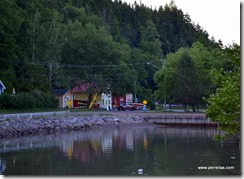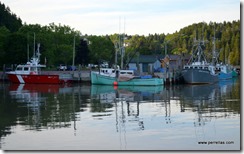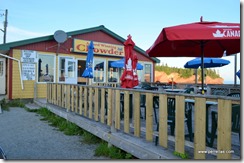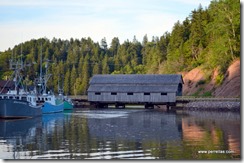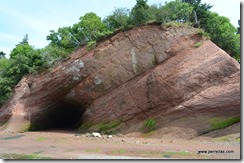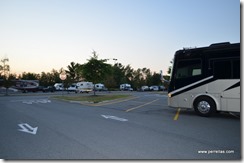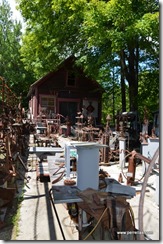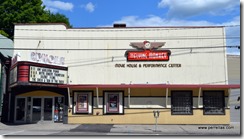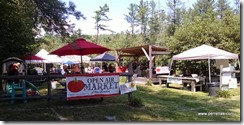Our NEXUS cards, KatieBug’s health record, our list of fresh veggies and fruits on hand to give to the border agents and our motor home, all in prepare-to-cross-the-border mode. We had planned to leave first thing in the morning but were stalled by visits to the local auto repair shop for our cars failed a/c., twice in one week. With the repair shops promise of getting us on the road before the end of Tuesday, we were able to pick up the car before noon, hook-up to our new-to-us car tow dolly and were on our way to Canada.
Overnight was at the Wal-Mart parking lot in Calais Maine, a short drive from the Canadian border. Tonight, anything fresh with a pit or seeds must be eaten, mashed or frozen and all pits, stems, seeds and peels must be removed from the motorhome.
The town of Calais has some incredible Victorian gingerbread trimmed homes lining the main street. Seeing beautiful vintage homes being repurposed into well cared for businesses is heartwarming. The houses are fashion forward forever. Such a waste when they chose to tear them down.
I asked John if there was anything else to declare. For the fourth time, having to listen to him say “don’t worry, we are OK” over and over, we were off to the border. Arriving with our list of produce in hand, we were asked to declare how much liquor we had in the motor home. Wait, what? I looked at John. John said “7 or 8 bottles”. We had not listed liquor, only fruit and veggies! We were directed to write down the type of liquor, size of the bottle and the amount in each bottle and present the list. Oh crap. Paper and pen in hand, I scurried to the bedroom and started listing. Returning and saying each one out loud to the border agent, stating again, we live in our motor home full time and some of the liquor has been sitting unopened for several years. He stared back unimpressed. Telling us we had exceeded the limit, we were instructed to bring the list inside the building. When I glared at John and asked him what was the limit, the guard answered for him. “You have a NEXUS card. You are supposed to know you are only allowed one bottle each.” Oh great. Long story short, John had not bothered to read the NEXUS rules. His excuse? They hadn’t asked us about liquor the last two times we crossed over the Canadian border. We paid $199.00 to bring our own liquor, some of it carried unopened for years, across the border. My mood, tone and remarks gave him warning, I was not amused.
On the road again with the constant pounding of the wheels hitting the pavement gaps, irritating the nerves in my spine, exceeding the relief my three lidocaine pain patches could mask. Coupled with a migraine, a reaction from the lidocaine, I stood in the back of the motorhome, bent over and resting on the counter, for the greater part of our journey.
After the back-jarring journey, costly fee and stress at the boarder to bring our unopened liquor over the Canadian border, we both were looking forward to an easy transition into normal retiree life, if only temporarily. Less than two hours later we arrived at Century Farm Family Campground in the Village of St. Martin. Our site was a huge pull through on level grass with a reasonably close view of the Bay.
Mathias Moran was granted the campground land in 1783 and the property has been in the Moran family ever since. The campground is basic, lots of seasonal couples, flat level sites, close enough to the bay to see the ripples of the water. No sand, just grit, rock and chilled crystal clear water. All in all, a great campground, site and view.
St. Martins is a Canadian village in Saint John County, New Brunswick Canada. The picturesque community, rich in seafaring history, is situated on the Bay of Fundy. The village was founded by Loyalists in 1783 and originally named Quaco. Over 500 sailing ships were built in this area in the 1800’s. Shipbuilding declined after 1870’s and lumbering, fishing and tourism took its place.
Slides out and levels down, all settled and ready to explore, we set off in search of either chowder or lobster, whichever we found first, for dinner. We drove into town, a three minute drive, and parked to walk the tiny Village of St. Martins. The village was comprised of a few brightly colored tourist shops, the bay and lobster boats.
At high tide, the bay swells with brackish water and the boats bob gently up and down. At low tide the boats rest tilted and squished into the muddy bottom of the bay.
Dinner would be seafood “chowder” at Sea Side Take Out Restaurant. The pronunciation reverts back to “chowdah” when we return to New England. The sea caves were visible from the restaurant, 200 yards from shore. Tomorrow the caves would be our destination
Surprised the town closes down early, we were only able to get chowder “to go” and drove back to LilyPad for dinner. A stroll along the shore before sea sounds lulled us to sleep.
Next morning, back into the village to explore and visit the caves. In the village are two covered bridges, still in use, within a block of each other and a lighthouse. St. Martin is the only place in the world where twin covered bridges and a lighthouse can be photographed in the same picture, although I chose to take photo’s of them individually.
The covered bridges sit next to the small inlet serving as lobster boat docks. The lighthouse was converted into the visitor center but closed each time we passed.
Past the village, through one of the covered bridges, up the hill and around the corner were the sea caves.
The sandstone Sea Caves are a UNESCO Fundy Biosphere. Accessible by foot during low tide, the crossing is rocky. It is a fair distance from the road and walking can be difficult on the large loose stones if you have ankle, knee or back problems. I had John and my cane and the will to have a firsthand experience instead of watching from the shore.
It was a beautiful day for a walk in the sunshine. Several of our neighborhood RV families had joined the bands of tourists rambling in the direction of the caves. One narrow water flow from land, easily crossed, then into the caves. The dark coolness inside was delightful.
Exchanging Kodak Moments with one of our neighbors, we poked around the receded ocean floor before joining the flow of tourists back to shore.
Next morning, off to the town of Sussex for groceries and supplies. Nothing worth a photo except Canada’s top selling breakfast cereal.
We did discover a fantastic thrift shop near the market and came out with a stack of intricate adult and easy kid puzzles to donate to Wellington’s stock of campground rec center activity supplies. After scrubbing four bathrooms, resting while working a 500 piece puzzle is an excellent way to allow body temperatures to cool down on a hot muggy summer day.
Packed up the night before, we arose early for the next leg of our journey, Charlottetown, Prince Edward Island, Canada. The summer flowers in shades of purple covered fields along the way.
To reach the island by vehicle, one must cross over the Confederation Bridge. It connects New Brunswick to Prince Edward Island (PEI). Atchafalaya Basin Bridge – 96,100 feet, between Baton Rouge and Lafayette is the longest bridge we have crossed with LilyPad towing, but the Confederation Bridge has been the most expensive.
Locals called the bridge the “fixed link” until its name was given upon completion. Most of the bridge is 131 feet above water. It took us about 15 minutes to cross the bridge and John was anxious to be on dry land. No fee on the way over, the toll applies only when leaving PEI and the rates are steep, almost $70.00 for our RV and car.
Cornwell Charlottetown KOA on Prince Edward Island was gigantic, fully packed with families and overflowing with little kids enjoying the last Canadian long weekend of the year. We reserved a pull through, not expecting it to be a premium site. What we got was a spacious and flat, front row corner, Bass Cove water view site. Lucky us…didn’t see one site better in the entire park!
After settling, we watched our neighbors bring up a bucket full of Quahogs from the low tide mucky sea bottom and we chatted about their catch. Next day another neighbor, with kids in tow, brought up a large bucket full of Quahogs and we discussed the process of bleaching out the sand for steaming their catch the next day. After watching two families hunt, dig up and clean the clams, it took mere seconds for John to decide clamming was too much work. My grandparents would have disagreed. They regularly took their travel trailer to Washington for the season and spent their days digging clams, dining on fresh steamers and enjoying sunsets from the beaches. Grandma would turn any clams not immediately enjoyed into a killer Italian clam sauce.
I had read about The Dunes Studio Gallery and Café in TripAdvisor and it sounded like an intriguing place for lunch. No wake up alarm was set so we got up late, took a relaxing walk across the bay floor at low tide with KatieBug before leaving to lunch at The Dunes.
On the way, we passed plastic wrapped dry hay marshmallows resting in a field next to a horse pasture. John had chatted with our neighbor in St. Martins and he told us the story of why the bales of hay are wrapped. Wet hay can ferment causing equines adverse health effects. Wrapping the hay at specific moisture levels, after cutting and drying, results in minimal fermentation and no problems with horse digestion. Cows, on the other hand, enjoy the fermentation of unwrapped bales of hay. Hmmm…we learn something new every day.
Reaching the Dunes shortly before lunch, we entered through the gift shop, put our name in at the Café and sat in the art gallery enjoying the mixed media works until our name was called. From our table, we could see the gardens outside and art in a patchwork pattern covering the walls of the floor directly above us.
Lunch, for me, was a huge bowl of mussels. PEI blue lipped are delicious and touted to be of premium flavor for aficionados. Like eating lobster in Maine, if you love mussels, this is the place. As the saying goes…when in Rome.
After lunch we wandered around the gift shop with the gardens luring us through huge picture widows all across the back of the gift shop. One particular piece caught my eye. The artist had draped a huge blown glass bowl inside tree limbs. All it needed was a bright orange long finned fan tail gold fish swimming around inside the glass globe.
The gardens were spread out along the length of the buildings and showcased a beautiful water garden just outside the back door. Reaching all the way into the sand dunes, the grass and gardens were spotted with natural wood formed outdoor furniture.
We sat watching the gardener dead heading flowers, clipping stray branches here and there and moving the watering hose from patch to patch. Love these moments of quiet peaceful downtime.
We exited a different door on our way out. The steps were decorated with ducks of all sizes, some costumed, some naked but wearing boots. 
We took the long way home to LilyPad and then the three of us meandered along the edge of the bay to stretch our legs before confining ourselves inside for the remainder of the day and night to do the necessary humdrum household chores. Dinner, TV and sleep.
Another early rise for our drive to Charlottetown Prince Edward Island (PEI), our destination for the day. Visiting a church, a lobster roll for lunch, window shopping through town and down to the docks, maybe some PEI mussels and back to our little bay side corner of peace and tranquility.
I wasn’t expecting hot weather so after our multiple block stroll through the historic shopping area of Victoria Row, we slipped into St. Dunstan’s Catholic Church, named for the Anglo Saxon saint from Glastonbury, for a quiet sit down and cool respite.
Next door sat the Board of Governor’s House. We didn’t enter but enjoyed the architecture from a bench outside.
Dave’s Lobster, a small fast food style restaurant near the wharf, was promoted as the best lobster rolls in Charlottetown so we were off in search of lunch. Walking down to the wharf at noon, right on schedule, we split a lobster roll.
Roaming around the wharf, enjoying the sea breezes while window shopping, made me hungry for more lobster. Our next restaurant choice was a re-visit from a cruise we took up the New England sea coast several years ago. I had a disappointing miniature, overcooked lobster tail. John had lobster poutine, a yummy meal of perfectly crisped French fries, a generous portion of cheese curds and lobster pieces with the entire mound coated in white seafood gravy. John willingly shared his huge heaping meal of heaven on a plate.
Poutine is a dish born out of rural Quebec in the 1950’s that consists of three ingredients: fries, brown gravy, and cheese curds. We were delighted with our first taste while in Quebec many years ago. Variations range from additional ingredients to a flavor choice of gravy. Fattening but excellent and a must try when in Canada.
Walking back to our car, we took a detour into the first place I had ever enjoyed a chocolate covered potato chip while exploring from our New England coast cruise. We walked from the ship to this shop. They call them Cow Chips and yummy is an understatement.
We drove home and took another walk along the bay ridge with KatieBug before days end.
After our uncomfortable crossing into Canada, tonight we typed all items needing to be declared and took out all things not able to pass through into the United States. Red bell pepper, frozen peaches, frozen nectarines, frozen cherries, avocado, all unable to enter the United States. It became our hodgepodge dinner and breakfast before leaving Canada. Unappealing as it was in combination, we washed it all down with the rest of the wine and whisky, also not allowed to cross back into the US without fees. No need for pain patches tonight.
Sad to leave our fantastic water view site and knowing our return to the states meant returning to workamping, I kept busy along the way taking pictures of signs, personalized for Canadian weather conditions and wild life situations.
A slightly different twist than those in the U.S., moose crossings, moose warnings, temperature warnings,
and can you believe the price of gas in Canada?
It’s a total bubble buster when you find out, in Canada, gas is sold by the liter.
Another tell tale sign you are in Canada is the overabundance of Tim Horton’s, Canada’s answer to Starbucks.
Our crossing into the United States was much more pleasant than our crossing into Canada. They asked us a few questions. Their response, when we told them we had a few bottles of liquor was, “a small bar?” We said yes, they said, “no problem” and “welcome home”. Whew. Next stop was Ames Brook RV Park in Ashland New Hampshire. One more week of retirement before we return to scrubbing bathrooms.
Our overnight was at Wally World RV Resort in Bangor Maine. We joined the dozen or so campers already set up, wandered around Wal-Mart until we were tired and dinned on Wal-Mart purchased frozen Lean Cuisine.
A few weeks prior, we had driven by Ames Brook, where we would be staying. We already knew which site was ours. Down gravel roads, sites of grass and gravel pads, shade trees surrounding us but none overhead. The perfect combination of shade without leaves or nuts pinging down on us or slapping LilyPad upside the head and clogging her slides and roof vents.
After setting up camp we scouted out the area. Down one side street we spotted Bernsen Art Gallery located in Ashland Maine. It occupies the 1849 Ashland railroad freight depot.
The artist, Bill Bernsen, describes his work as “found object art and assemblages”. His elderly fur baby stayed close by his side.
The metal art is amassed in a storage barn, spilling out into his side yard adjacent the depot. One interesting piece of metal assemblage is called “Eleven Saws”. When you count them, there are only 10. In a play on words for the title, the 11th is that you “saw” the art piece.
Fun and fanciful, the bicycle built for two was my favorite.
The outside explored, we stepped upstairs to view the interior gallery. Before entering, I paused to enjoy the whimsical faces hanging on the sliding wooden barn door.
We stepped into a room with highlighted walls displaying an interesting departure from cold hard metals. Back lit and suspended were a half dozen wood relief pieces, a complete about-face from inflexible metal to malleable organic materials. A thoroughly enjoyable display. When our visit came to an end, we thanked Bill for the experience and drove on to explore more of the area.
Back to our campsite to make ready for our night out at The Flying Monkey venue. Tonight we will dine while enjoying a concert with the fabulous Big Bad Voodoo Daddy band. We were delighted with their performance at the Mitchell Pavilion in The Woodlands and were excited to relive the experience. Dinner was decent but nothing special. The concert was entertaining but lacked the lively jitterbugging troupe of groupies who had danced at the front of the Mitchell Pavilion stage. Still, the music was marvellous, totally worth the cost.
Comfortably in our relax mode, we noticed a poster advertising the New Hampton Open Air market down the street from our campsite. Early up the next morning to check out the produce and eggs, all the while being serenaded by Blue Grass music. Tomorrow, for breakfast, we shall dine on just picked sautéed veggies and newly laid scrambled eggs.
Our farm fresh breakfast cooked, eaten, and dishes cleaned, we drove to The Tilton New Hampshire concert series sponsoring the Rockin Daddios DooWop acapella quartet. The audience was mainly oldies with a few children twirling around at the foot of the stage. Songs were from my teen era, John’s young adult years. Even KatieBug enjoyed our sit-back-and-relax afternoon.
Two more days of tranquility. Looking up Best Breakfasts on line, we chose The Heritage Farm Pancake House.
Everything is served family style and most of the tables will seat a huge family with room to spare. The dining rooms were inside upstairs, inside downstairs, outside on the front porch and outside in the massive barn. A petting zoo occupied the field behind the barn.
There were so many people arriving who ended up in the kitchen helping, I had to wonder why…until I saw two young men in white shirts, black dress pants and ties sitting at a table in the small entrance dining area, bible open, discussing the Good Book. When the young men finished their chat, they got up, walked outside to the porch and began clearing tables. Shortly afterwards, they paused to sit and speak with a couple who had just finished breakfast. After we had enjoyed our breakfast and were on our way out, the young men had settled in with another couple at a corner table and were in a deep concentrated discussion.
I’m not one to believe in the afterlife making contact with us down-on-earth folks, but in the moment, I was struck with an eerie thought. Perhaps finding this religious country farm restaurant was not an accident but a sliver of cosmic payback. Cheryl, a dear childhood friend of mine, passed away a few years back. Cheryl had become a Jehovah’s Witness as an adult and often requested me to accompany her to one of their services. I refused although she kept asking. When she had left this earth, I was sad to have put this small favor off for so long. Perhaps a spirit had guided us to this particular restaurant. I could almost hear her deep Jolly Santa laugh and imagine her watching to see if I got the connection. Not in life but in afterlife, she might have drawn me to the people of her church. My Chunky Monkey pancake was fabulous. Thanks Cheryl, and yes, we still miss you!
In preparation of our drive up Mt. Washington, we visited The Museum of the White Mountains at Plymouth University. The museum was hosting an exhibit dedicated to the women who used the mountainous region to explore their talents and creativity, uninhabited by the constraints of urban life.
The first European to ascend the mountain was Darby Field in 1642 but women played a sizeable role, shaping and popularizing the White Mountain region using art, first- hand accounts, clothing and photographs.
While we walked through the museum, one of the curators approached us, mentioning she had also attended Chico State, referring to the Chico State T-shirt John was wearing. It amazes me how many “small world” examples we stumble upon while rolling across the US of A.
Another quiet night, waking early the next morning to be on the road for our climb up Mt. Washington. John wanted to drive to the top and explore, so after paying the drive-up fee, popping in the accompanying CD and shifting to low gear, we crept slowly up the Mt. Washington Auto Road, America’s first manmade attraction. The audio tour was interesting and the ability to stop at pull-outs on our way up, allowing us to stretch our legs and backs, was much appreciated. Our first pause and stretch, the tree line.
Cairns, stone piles placed along hiking trails, are noticeable from every direction at the pull-outs where there are trails. From prehistoric time to the present, they are often erected as landmarks but on this mountain, they are signs stating someone has passed this way. You can see the ski slopes in the distance far below.
Fog floated across the lower mountain areas but by the time we had reached the 6288 foot summit, the skies had cleared considerably.
From the summit, we watched dozens of ant size hikers begin their wind down the trails.
Mount Washington, called Agiocochook by some Native American tribes, is the highest peak in Northeastern United States and the most prominent mountain east of the Mississippi River. The mountain is notorious for its erratic weather and has a plaque mounted near the historic Tip-Top House revealing top wind speed of 231 miles per hour recorded on April 12, 1934.
Mount Washington State Park is a 60.3 acre parcel perched on the summit of the peak. It is surrounded by the extensive 750,000 acre White Mountain National Forest. On a clear day, you can see as far as 130 miles to Vermont, New York, Massachusetts, Maine, Quebec and the Atlantic Ocean.
The historic Tip Top House is the former hotel in Mount Washington State Park. It is the oldest surviving building on the summit of Mt. Washington and believed to be the oldest surviving mountain-top hostelry in the world. When we visited, it featured exhibits of the mountain’s hotel/hostel history. The rock walled building, with tiny windows and claustrophobic rooms, was so dark, pictures were not attainable.
Our drive down the mountain was uneventful, stopping along the way to stretch and breath in the fresh air. It’s been a welcome and relaxing stretch of days here in Ashton New Hampshire but our workamping job is calling us back. I am thankful and grateful for all the fun musical events that kept us entertained and the quiet shaded campground site located near a multitude of interesting areas to explore. We have booked a return, in late September, for another week of relaxation before taking the long and winding road leading us through Canada, South Dakota, Alabama and finally back to Texas.
Our last day of relaxation and the “It’s always something” demon struck, the first of many to follow. When rinsing the black tank, full attention to the job is necessary. Not paying attention results in the tank overfilling with black water (toilet waste water), bubbling up into the air release pipe, overflowing and pouring down behind our washing machine. John had set his watch alarm but didn’t hear it go off. His first clue that something was amiss was me screaming “water is splashing down behind the washer”! After stopping the water flow and beginning the long clean up process I thought…damn I miss lunching with my girlfriends and being able to bitch about the dumb ass things our husbands do. Go ahead and laugh…everyone else might as well appreciate the humor of our rolling comedy of horrors. If the third time is the “charm”, it had also better be the absolute last. Once again, I was not amused.
Arrived mid-day at Wellington, backed up into our site, settled down for the night, sleep. Up early, time to return to another five days of sweating for us oldies, dislodging mud and grimy gritty beach sand from old toilets, showers, sinks and floors, the heat and humidity trapped inside the old worn out wooden bath houses with only screened windows and a door to allow in air. Our cool down ritual continues, piecing together the jigsaw puzzles in the rec center, both barn doors open wide to capture any breeze.
Temperatures in Lee New Hampshire were not what I expected. My thinking was the closer we were to Canada, the cooler and less humid the weather. Not so. Last year and this, the locals claimed they were experiencing the hottest most humid summers in history. It seems Texas heat is determined to tag along with us where ever we go.
Our next escape, when our work week ends, will be local entertainment and a visit with family. And now…back to what normal people never refer to as “retirement”.




